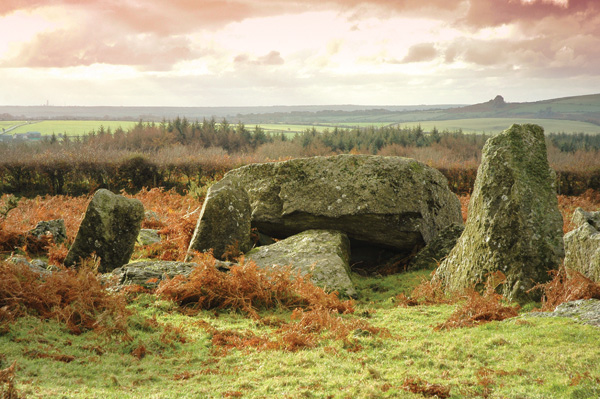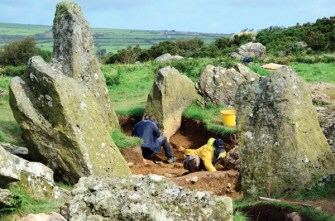Exploring Neolithic construction at Garn Turne
Well known on the Continent and scattered along the coasts of Wales, Cornwall, and Ireland, dolmens are an immediately recognisable form of chambered tomb. They represent remarkable achievements for their Neolithic builders, crowned with stones weighing as much as 160 tonnes. Vicki Cummings and Colin Richards investigate how these distinctive monuments were constructed — and what happened when a project did not go to plan.

Of all of the kinds of chambered tomb that are found in Britain and Ireland, dolmens are perhaps the most iconic — and the least understood. Yet their composition is very simple: to create a dolmen, you simply place a large slab or ‘capstone’ on top of three or more upright stones, creating an open, box-like chamber. So far, so straightforward — except for the small matter of raising the capstone. In order to get a better idea of how these dolmens were engineered, we began a campaign of excavations at Garn Turne Major in Pembrokeshire, home to the largest surviving capstone from a British megalithic monument.
Weighing in at around 80 tonnes, the Garn Turne Major capstone is a truly massive slab of rock. To put this in perspective, the great sarsen stones at Stonehenge weigh on average 25 tonnes. But even Garn Turne cannot compare with the absolutely colossal capstone at Brownshill, Co. Carlow (Kernanstown), which at 160 tonnes ranks as one of the largest known anywhere in Europe.
Tomb with a view
Building these mighty monuments using prehistoric technology was an incredible feat — something their proud creators were apparently eager to highlight. The capstones often balance precariously on the tips of the supporting slabs beneath. Was this showboating designed to draw attention to the prowess of those assembling sites like these? To us, this delicate arrangement indicates that the cairn material sometimes found around such monuments served a radically different purpose to the traditional view: these are not the vestiges of a lost burial mound, but packing to keep the uprights in place.

It has long been assumed that all chambered monuments were encased within a mound or cairn. In the case of dolmens this would mean that the stone frame was only visible because the mound had weathered, or been robbed, away. There is very little supporting evidence for this, however; sometimes you find a small platform of cairn material around the base of the dolmen, but often there is nothing at all. Rather than the material having been removed at a later date, it seems much more likely that these fantastic constructions with their impressive capstones were meant to be admired, not obscured. Dolmens are visually spectacular sites, with a design geared far more towards ostentatious display than the practicalities of a burial space.
Previous studies of dolmens have tended to focus on architecture and burial chamber contents — both complex subjects, not least because extensive local variation makes it difficult to slot these monuments into any neat typological scheme. Their design has also frustrated generations of archaeologists attempting excavation; dolmens are effectively open boxes that have been exposed to the elements — and curious fingers — for millennia. Few dolmens produce the quantity of material that is typically found in other forms of Neolithic chambered tomb. When material is recovered, analysis is complicated by the fact that these sites clearly saw depositions over very long timescales, often thousands of years.
Our project took a different approach, exploring how dolmens were constructed. We think that, first, prehistoric builders identified a suitable rocky outcrop and prised off the upper surface to create their capstone — hence most of them have a natural, weathered upper surface, while their underside is flatter. Sometimes glacial boulders were used instead, but the underneath was still carefully shaped, to help them balance on the upright supports. These uprights were also quarried stones, with their inner sides smoothed and the outer left natural.
This deliberate working of the surfaces makes dolmens the earliest form of monument in Britain and Ireland to incorporate quarried and shaped stones. While excavating at Garn Turne Major we found debitage created when its huge capstone was flaked into shape using massive hammerstones. Dating back to 3790-3640 cal BC, this represents the oldest-known evidence of stone-working in Britain, pre-dating Stonehenge by around 1,000 years.
Deconstructing Garn Turne
In the summers of 2011 and 2012 we opened a large trench at Garn Turne, which revealed multiple phases of activity, including the remains of at least two dolmens. When we first arrived on site, the monument’s forecourt — an open area perhaps for assembly — appeared to have a natural outcrop in the middle of it, an arrangement unparalleled at other dolmen sites in Britain or Ireland.

Our investigation revealed that this ‘outcrop’ was in fact a quarried stone, sitting on the edge of a pit — probably its source — that contained traces of intense burning. Charcoal from this area was radiocarbon dated to 3702-3639 BC. The stone, which we named the Floss Stone after a dog belonging to one of the diggers, was partly set on a rammed-stone platform that had been cut by another large pit, which lies directly in front of Garn Turne Major and probably once housed its capstone. Radiocarbon analysis of burnt hazel found in this second pit suggests the dolmen was constructed in c.3787-3656 BC or 3761-3643 BC. Stratigraphically there is evidence that the Floss Stone was quarried and moved before Garn Turne Major’s construction — perhaps it was initially intended to be part of the monument, or played a role in the building process, but it could have been a special, sacred stone in its own right.

This was not the only activity pre-dating Garn Turne Major, however: we also found evidence of a smaller dolmen, dubbed ‘Garn Turne Minor’, directly to the north-west. Prior to excavation, only its capstone was visible, but our trenches revealed a number of collapsed orthostats alongside this. It seems that the monument had once stood in a large pit, much like Arthur’s Stone on the Gower, but at a later date, after it had collapsed, the dolmen was surrounded with a platform of stones and soil, hiding the pit and toppled uprights. A series of smaller standing stones were erected around the fallen capstone — perhaps commemorating the monument, or marking its destruction.

Our site was not isolated in the historic environment. We also identified a series of standing stones in the immediate vicinity, placing the dolmens in a broader monumental landscape. Garn Turne Major’s forecourt, constructed partly in the remains of the massive quarry pit in front of the monument, was apparently added at a later date. Analysis of this layer of the pit yielded dates in the Late Neolithic or Early Bronze Age (2464-2210 BC, and 2618-2470 BC). Another radiocarbon date from higher up in the pit is from the Iron Age (800-547 BC), which — together with the discovery of iron slag — suggests that the dolmen had a long and eventful use in prehistory.
Dolmen disasters
One thing that became clear during the course of our investigation is that things did not always go to plan when building these monuments. There are many surviving examples of dolmens where problems in the construction process can be seen. Garn Turne Major was apparently never completed after its capstone collapsed. At Brownshill the builders seem to have had even greater difficulty getting their project off the ground: perhaps overambitious in estimating the weight they would be able to lift, ultimately the workmen had to make do with only elevating the front part of their record-breaking capstone, while to this day the rear remains firmly rooted to the ground.
It is not surprising that disaster struck when working with such massive and unwieldy materials. At other sites there is clear evidence of capstones breaking, collapsing, or slipping off their supports. The Neolithic builders do not seem to have helped themselves, however. Many times we have observed monuments where prepatory groundwork was shoddy at best: upright slabs had not been firmly bedded in the ground, but were effectively propped against one another for support, like a house of cards. It is no shock, then, that once a massive capstone was placed on top these unstable constructions often went awry.

Chocks away: raising the capstone
How did people manage to shift such enormous stones 6,000 years ago? During the Neolithic period, building materials for monuments were most likely moved using a combination of ropes, levers, wooden rollers, and grease, with people and possibly animals such as oxen providing the muscle. When constructing a dolmen, however, no such shifting was required.
 Our excavations have shed some light on how the feat was achieved. After the capstone had been quarried from the bedrock, the monument could be built directly above it, allowing the stone to be raised in situ using levers. Once one end had been raised even a few inches, chocks (probably a combination of timbers and stones) could be placed underneath. The builders could then lever up the other side and put more chocks under it. Repeating this process would slowly elevate the capstone until it was in the right position.
Our excavations have shed some light on how the feat was achieved. After the capstone had been quarried from the bedrock, the monument could be built directly above it, allowing the stone to be raised in situ using levers. Once one end had been raised even a few inches, chocks (probably a combination of timbers and stones) could be placed underneath. The builders could then lever up the other side and put more chocks under it. Repeating this process would slowly elevate the capstone until it was in the right position.
It was then time to remove carefully small portions of this material in order to put in the upright supporting stones. Finally, when all the uprights are in place, any remaining chocks could be removed and — voila! — you have a finished dolmen. This method is much easier than dragging the capstone up a ramp and onto the uprights — though it was during this final phase of construction that everything went wrong at Garn Turne Major: when the final support was removed, the uprights could not hold the capstone’s weight, and the monument collapsed.
This feature appeared in issue 286 of Current Archaeology.




Browns hill dolmen is not “rooted to the ground” at the back but rather balances on a small slab….
The above is excellent observation, showing the Browns Hill dolmen is not a collapsed monument. It is a genuine engineering feat and a ritual shamanic work of art!
A man with a shovel could build a dolmen if he selected stones elevated in a drumlin and guided them into position.
But they didn’t have modern shovels. In fact what were the levers?
If the dolmen cap Stones were lifted into position why We’re some unsuccessful ones abandoned.
Very cool. Im gonna build one on my property! Hehe! Have some boulders.